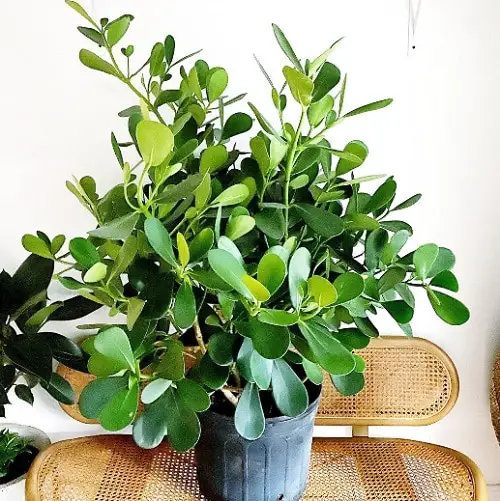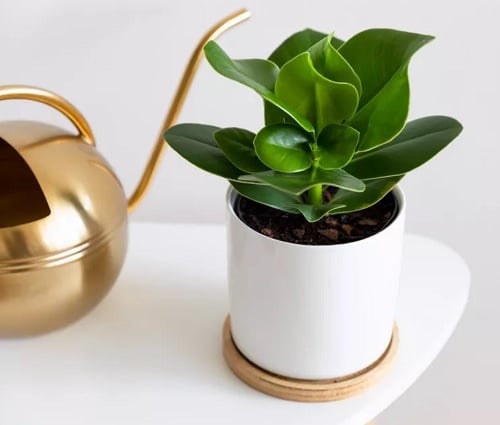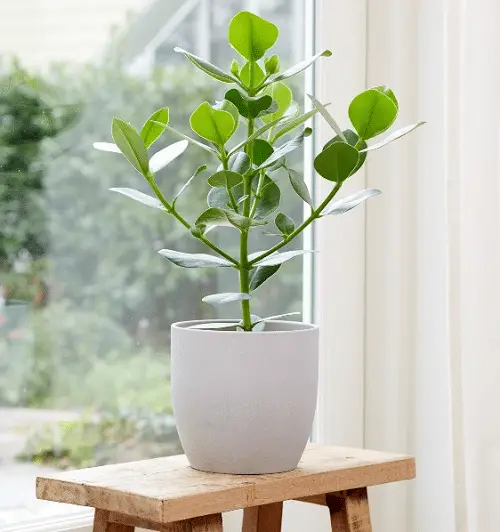The only plant in the world, whose leaves you can use to write messages, names, and signatures. Discover all the details about Autograph Tree Care Indoors!
Clusia rosea features beautiful dark olive green, leathery leaves with a somewhat elliptical shape. But that is not what it is known for–You can write on it, and that’s why it’s called an ‘Autograph Tree.’ It is also prized for absorbing Co2 at night, which makes it a great houseplant. If you too want to grow it, here’s all the information you need on Autograph Tree Care Indoors.
Botanical Name: Clusia rosea
Common Names: Copey, Balsam Fig, Pitch Apple, Scotch Attorney, Signature Tree
USDA Zones: 10-11
Check out our article on Nerve Plant care here
What is an Autograph Tree?
Autograph Tree is native to tropical America, noteworthy for its tendency to grow on other plants. It can grow up to 20-25 feet tall and features stiff, leathery dark green or olive-colored leaves. The plant flowers in pink or white shades with long flower heads during summer and grows small green fruits that ripen to black and split open to showcase bright red seeds, loved by birds.
How to Grow the Autograph Tree

If you have an autograph tree around you, then you can simply detach the stems and replant in warm moist soil and allow them to root. You can also get a plant from a nursery or search online.
Container Size
Move the plant to one size bigger pot after getting it from the garden center. Giving roots enough room to spread will result in a much taller and healthier plant. When it becomes root bound, the growth will be slow, and you’ll have to repot it to a pot one size bigger than the rootball.
Note: Do remember that using too big container results in moisture retention in the soil that may cause root-rot.
Requirements for Growing Autograph Tree

Location
If your room receives plenty of bright indirect light, it will grow! A spot near a window or door that gets a patch of direct sunlight is ideal for placing it.
Soil
Soil that is loose and drains well is ideal for most of the houseplants, and the autograph tree is no different. You can select a potting mix that you use for fiddle leaf fig and rubber plant for this plant too.
Water
While this plant prefers moist soil in an outdoor setting, it’s better to avoid keeping the soil saturated in indoor conditions. Water your indoor autograph tree thoroughly when the soil seems dry and then wait for some time until your growing medium dries out again.
Temperature
The plant prefers warm tropical conditions and thrives in the temperatures between 60 to 85 F (15 to 30 C), which is in the average indoor temperature range. The autograph tree cannot resist cool temperatures below 50 F (10 C), so save it from cold drafts in winter.
Humidity
Growing autograph plant indoors is similar to rubber tree–both love humidity and if you’re using appliances like a home heating system or air conditioner, they can make the air in your home dry, using a room humidifier is a nice solution or try one of these tricks here.
Autograph Tree Care

Fertilizer
Feed with half-strength all-purpose liquid fertilizer once a month during the growing period. Avoid application in winter, especially in cold climates.
Note: As the plant loves organic matter, you can also apply compost instead of chemical fertilizers.
Repotting
An autograph tree is a fast-growing plant, so you may have to repot it once every year or two if it outgrows the existing pot. Do this in warm weather and select one size bigger pot for this purpose, or if you like to keep it growing in the same pot, just trim some of the circulating outer roots and the ones that are thin, threadlike, and non-woody. Avoid damaging the most dominant main roots!
Toxicity
This plant is listed as a mildly toxic plant by the FDA. Its fruits are toxic and ingestion can cause symptoms like diarrhea and stomach upset. It’s advised to remove fruits from the plant, once they appear.




Do U sell small autograph plant & post to Queensland